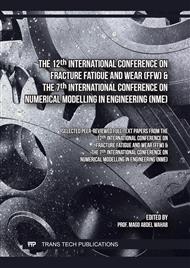[1]
I. Energy Agency, "Review 2021 Assessing the effects of economic recoveries on global energy demand and CO 2 emissions in 2021 Global Energy," 2021. [Online]. Available: www.iea.org/t&c/
Google Scholar
[2]
A. Smith, B. Jones, and C. Johnson, "Advanced computational models for predicting wind turbine performance in diverse environmental conditions," *J. Wind Eng. Ind. Aerodyn.*, vol. 192, pp.75-85, Nov. 2019.
Google Scholar
[3]
D. Paraschivoiu, L. Battisti, and M. G. McTavish, "Review on vertical axis wind turbines: An evolutionary approach to wind energy harvesting," *Renew. Sustain. Energy Rev.*, vol. 145, pp.111-123, Jan. 2021.
Google Scholar
[4]
J. Mohamed, T. Maalouf, and S. Bouhicha, "A comprehensive review on vertical axis wind turbines: Small-scale applications and aerodynamic analysis," *Energy Convers. Manage. *, vol. 234, p.113913, May 2021.
Google Scholar
[5]
E. A. D. Kumara, N. Hettiarachchi, R. Jayathilake, E. A. D. Kumara, N. K. Hettiarachchi, and K. G. R. M. Jayathilake, "Review Paper: Overview of the Vertical Axis Wind Turbines," 2017. [Online]. Available: https://www.researchgate.net/publication/319678764
Google Scholar
[6]
R. Gupta and K. K. Sharma, "Flow physics of a combined darrieus-savonius rotor using computational fluid dynamics (CFD)," 2012. [Online]. Available: http://www.interesjournals.org/IRJESTI
Google Scholar
[7]
M. Meziane, E. Essadiqi, M. F. Ghanameh, "Numerical Investigation of Hybrid Darrieus-Savonius Wind Turbine Performance," Journal of Renewable and Sustainable Energy, vol. 12, no. 4, pp.657-665, 2023.
DOI: 10.1063/5.0016372
Google Scholar
[8]
N. Fujisawa and F. Gotoh, "Experiments in Fluids Visualization study of the flow in and around," 1992.
Google Scholar
[9]
P.M. Kumar, M.R. Surya, K. Sivalingam, T.C. Lim, S. Ramakrishna, and H. Wei, "Computational optimization of adaptive hybrid Darrieus turbine: Part 1," Fluids, vol. 4, no. 2, Jun. 2019.
DOI: 10.3390/fluids4020090
Google Scholar
[10]
G. Saini and R. P. Saini, "A numerical analysis to study the effect of radius ratio and attachment angle on hybrid hydrokinetic turbine performance," Energy for Sustainable Development, vol. 47, p.94–106, Dec. 2018.
DOI: 10.1016/j.esd.2018.09.005
Google Scholar
[11]
J. Jacob and D. Chatterjee, "Design methodology of hybrid turbine towards better extraction of wind energy," Renew Energy, vol. 131, p.625–643, Feb. 2019.
DOI: 10.1016/j.renene.2018.07.064
Google Scholar
[12]
P. M. Kumar, M. R. Surya, K. Sivalingam, T. C. Lim, S. Ramakrishna, and H. Wei, "Computational optimization of adaptive hybrid Darrieus turbine: Part 1," Fluids, vol. 4, no. 2, Jun. 2019.
DOI: 10.3390/fluids4020090
Google Scholar
[13]
Eiji Yoshimura, "Tornado Wind Turbines," https://tornado-japan.jp/en/whats/.
Google Scholar
[14]
S. M. Rassoulinejad-Mousavi, M. Jamil, and M. Layeghi, "Experimental study of a combined three bucket H-rotor with savonius wind turbine," World Appl Sci J, vol. 28, no. 2, p.205–211, 2013.
Google Scholar
[15]
J. Schijve, "Fatigue of structures and materials in the 20th century and the state of the art," Aug. 2003.
DOI: 10.1016/S0142-1123(03)00051-3
Google Scholar
[16]
A. Bianchini, F. Balduzzi, D. Di Rosa, and G. Ferrara, "On the use of Gurney Flaps for the aerodynamic performance augmentation of Darrieus wind turbines," Energy Convers Manag, vol. 184, p.402–415, Mar. 2019.
DOI: 10.1016/j.enconman.2019.01.068
Google Scholar
[17]
H. Alizadeh, M. H. Jahangir, and R. Ghasempour, "CFD-based improvement of Savonius type hydrokinetic turbine using optimized barrier at the low-speed flows," Ocean Engineering, vol. 202, Apr. 2020.
DOI: 10.1016/j.oceaneng.2020.107178
Google Scholar
[18]
A. Bianchini, F. Balduzzi, D. Di Rosa, and G. Ferrara, "On the use of Gurney Flaps for the aerodynamic performance augmentation of Darrieus wind turbines," Energy Convers Manag, vol. 184, p.402–415, Mar. 2019.
DOI: 10.1016/j.enconman.2019.01.068
Google Scholar
[19]
T. Wakui, Y. Tanzawa, T. Hashizume, and T. Nagao, "Hybrid configuration of darrieus and savonius rotors for stand-alone wind turbine-generator systems," Mar. 2005.
DOI: 10.1002/eej.20071
Google Scholar
[20]
G. Ferrari, D. Federici, P. Schito, F. Inzoli, and R. Mereu, "CFD study of Savonius wind turbine: 3D model validation and parametric analysis," Renew Energy, vol. 105, p.722–734, 2017.
DOI: 10.1016/j.renene.2016.12.077
Google Scholar
[21]
W. Tian, Z. Mao, and H. Ding, "Numerical study of a passive-pitch shield for the efficiency improvement of vertical axis wind turbines," Energy Convers Manag, vol. 183, p.732–745, Mar. 2019.
DOI: 10.1016/j.enconman.2019.01.006
Google Scholar
[22]
J. F. Manwell, J. G. McGowan, and A. L. Rogers, "Front Matter," in Wind Energy Explained, Wiley, 2009.
DOI: 10.1002/9781119994367.fmatter
Google Scholar
[23]
K. Y. Lee and J. S. Kim, "Design optimization of wind turbine blades for enhanced efficiency and durability using computational fluid dynamics," *Renewable Energy*, vol. 145, pp.365-378, Jan. 2020.
Google Scholar


